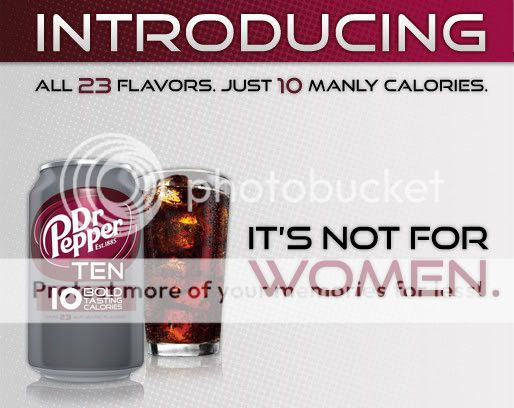 If you have to explain the joke, it might be that the joke’s just not funny. This is conventional wisdom (at least for comedians), but it seems to have escaped the marketing team at Dr. Pepper. Their latest offering, a campaign for Dr. Pepper 10, declares that the beverage is not for women. The social media aspect of the campaign includes a Facebook campaign where users can shame their friends for being insufficiently manly and a game that involves shooting at traditionally female symbols, such as high heels and lipstick.
If you have to explain the joke, it might be that the joke’s just not funny. This is conventional wisdom (at least for comedians), but it seems to have escaped the marketing team at Dr. Pepper. Their latest offering, a campaign for Dr. Pepper 10, declares that the beverage is not for women. The social media aspect of the campaign includes a Facebook campaign where users can shame their friends for being insufficiently manly and a game that involves shooting at traditionally female symbols, such as high heels and lipstick.
Response to the campaign has ranged from the infuriated to the perplexed. Forbes magazine termed the campaign “bizarre“. Perhaps, they reasoned, the campaign was tailor-made to generate internet buzz and scandal. The resulting boost in name recognition might more than offset any business lost from those shoppers infuriated by the misogynistic overtones of the campaign.
We can’t speak to the intent of the campaign, but it’s not hard to speculate about its eventual outcome. While the “It’s Not For Women” approach might resonate strongly with the contingent of diet soda drinkers who also believe girls have cooties, it’s doubtful that portion of the market is long enough to support the brand. Dr. Pepper’s response to consumer criticism of the campaign includes the following explanation of their motives:
We have a huge female customer base that has been satisfied with Diet Dr Pepper as their beverage of choice for years; however we learned through extensive market research that there was a gap in our male audience that was looking for a low-calorie alternative to regular Dr Pepper that lacked the diet imagery. We created Dr Pepper TEN to fill that void. Dr Pepper TEN features steel-grey packaging with rivets and a manly tagline, “It’s Not For Women.”
Here, we see Dr. Pepper identifying a fairly specific opportunity in their marketplace: men who wanted a diet alternative to Dr. Pepper. Diet Dr. Pepper already exists, but these men weren’t buying. The reason why? Discomfort with the traditional diet imagery was apparently to blame. Offering those consumers a product without the traditional diet imagery seems like a straightforward conclusion. The mystery is why Dr. Pepper chose, among the hundreds of thousands of potential ways they could have positioned their new diet soda, as choose A lady-free zone of rugged, macho, hair-on-your-chest awesomeness that’s definitely not for women. Of all of the approaches possible, why did Dr. Pepper feel that this is the approach their customers would find most appealing?
Brand Modeling and the Search for Meaning
Brand Modeling teaches us that the most effective way to capture customer attention, drive sales, and increase market share is to develop a comprehensive understanding of our best customers’ wants, needs, and desires. Thus equipped with in depth knowledge of our customer and what influences their purchasing behavior, we can create products and offerings they are highly likely to adopt with enthusiasm.
Had Dr. Pepper done this, it would have meant exhaustively examining their best customers—especially those loyal, enthusiastic Diet Dr. Pepper drinkers who were also male. Determining what drew them to choose Dr. Pepper, points of tension where the brand could serve them better, and the most appealing way to package and promote the beverage is all information that would play a critical role in building a new brand extension.
What would the result look like? Chances are the model wouldn’t be quite as exclusionary; not to overgeneralize, but many men do seem to exhibit a strong preference for spaces that have women in them. Using the tools Brand Modeling provides would allow Dr. Pepper’s leadership team to compare, ahead of time, the likely public response to any projected marketing message. This objective assessment allows apples to apples comparison.
Would Dr. Pepper still have chosen this campaign? Given other, accurate and actionable insight, they may have decided that crafting a brand community that encourages male participation and buy in may become far easier when you invite women in, rather than keep them out.
